There’s luck and there’s luck, and I consider arriving in Avignon 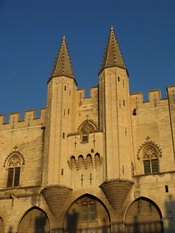 from Marseilles at dusk on a spring day, with the fading sun casting honeyed light upon some of the most impressive medieval structures in Europe, and my camera in my pocket, at the ready — I consider that very good luck.
from Marseilles at dusk on a spring day, with the fading sun casting honeyed light upon some of the most impressive medieval structures in Europe, and my camera in my pocket, at the ready — I consider that very good luck.
I was in Avignon for the biannual event held in the Rhône Valley called, appropriately, Decouvertes en Vallée du Rhône (Discover the Rhône Valley) and there simply isn’t a better way to do so than to attend this event. 800 producers arranged by appellation were pouring, with venues and entire days devoted to the wines of a given region — Gigondas one day, Vacqueyras another, a Tavel morning, a Lirac afternoon.
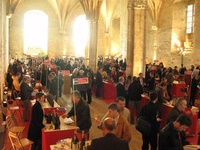 Most of the tastings take place in the extraordinary Palais des Papes in the heart of Avignon. What better place to taste 100 Chateauneuf du Pape wines than in this place, with its history and its extraordinary link to the wines in the glass?
Most of the tastings take place in the extraordinary Palais des Papes in the heart of Avignon. What better place to taste 100 Chateauneuf du Pape wines than in this place, with its history and its extraordinary link to the wines in the glass?
The Rhône Valley consists of 17 appellations, eight in the north and seven in the south, though the south is home to most of the vines that make up the last two appellations, Côtes du Rhône and Côtes du Rhône Villages, which of course makes up the bulk of the production.
That production is enormous, second only to Bordeaux in France. And yet the region is home to the smallest appellation in the country (Chateau Grillet), and to appellations so small and limited in production that they remains scarce to this day. To make matters more confusing, 22 grape varieties are in use in the entire appellation. While this may seem designed to confuse the average wine lover, it’s actually what makes Côtes du Rhône wines so consistently enjoyable, and nearly always well-priced. The components in the best instances are used to build some unfailingly balanced and drinkable wines. That is certainly true of 2006 and 2007, two of the most charming Rhône vintages that have hit the market in recent years. In village after village the wines were cleaner, more consistent, more direct, and more exuberant than any in recent memory.
Meanwhile, producers of heavier-hitting reds — Hermitage, Côte Rotie, and Chateauneuf du Pape — were showing mostly their 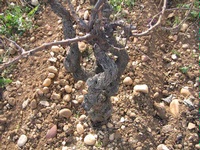 2006s, after a long elevage. The Chateauneuf wines were unbridled in their power, and there was plainly a dividing line between the wineries who have embraced an international style and ones whose sentiments remain firmly planted in the rocks of those impossibly stony vineyards.
2006s, after a long elevage. The Chateauneuf wines were unbridled in their power, and there was plainly a dividing line between the wineries who have embraced an international style and ones whose sentiments remain firmly planted in the rocks of those impossibly stony vineyards.
For those wines the Grenache displayed that variety’s strength while not forsaking its almost delicate, red-fruited elegance. In other cases, however, typicity had given over to a kind of chunky, mouth-filling power, leaving room for little else; the wines may as well have come from Australia.
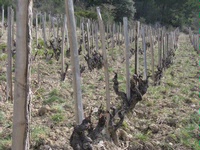 There is still charm in the wines of the adjacent appellations Gigondas and Vacqueyras, as well as the delightful wines of Cairanne. The 2006s have a lifted, exuberant fruit component that gives even the most rustic wines some additional polish and charm.
There is still charm in the wines of the adjacent appellations Gigondas and Vacqueyras, as well as the delightful wines of Cairanne. The 2006s have a lifted, exuberant fruit component that gives even the most rustic wines some additional polish and charm.
Of the northern Rhône appellations it was a fantastic opportunity to taste Côte Rôtie in abundance; the 2006s are more approachable and more forward than they’ve ever been, but show no less polish or elegant structure for it. But I think I was the most impressed with the Hermitage reds, which are grand, 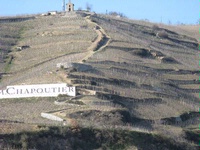 powerful, and tightly coiled in their youth, showing strength and longevity at this point.
powerful, and tightly coiled in their youth, showing strength and longevity at this point.
Among the whites, five varieties are the main players: Viognier, Marsanne, Roussanne, Grenache Blanc, and Clairette. Each variety has a traditional home, and each has surprisingly firm adherents. In Hermitage, Marsanne is the predominant white grape, where it can produce wines of firm, sturdy grace. For me, however, the wines using significant percentages of Roussanne were the more arresting ones, showing some of the most power. The whites of St. Peray, a lesser known appellation on the southern end of the Northern Rhône, represent some of the more precise expressions of Roussanne in the Rhône Valley, a slightly lighter style with a bright acidity that southern Rhône Roussannes do not possess.
Both Marsanne and Roussanne can provide an almost majestic richness and textural complexity, but their flavors, however wonderful, fall within a limited range. This is why the experience of tasting Condrieu in abundance, made from the Viognier, was one of the more profound tasting experiences of my life.
The Condrieu appellation is tiny, and the number of producers small. It is rare to taste Condrieu at all, much less to taste several at one sitting, and this was one of those great opportunities to see what a world-class grape can offer in a great vintage. Condrieu wines have a broad range — they can be big, fleshy, voluminous, or they can be more austere and mineral — but the flavor spectrum does seem very strictly defined, as if the soils keep the Viognier’s natural exuberance in check. The resulting wines can be rich and almost showy, but they nearly always display an astonishing, jewel-like clarity.
Viognier is known for its exotic fruit spectrum, peach, nectarine, apricot, sometimes pear, but Viognier from Condrieu adds a profound textural experience to this: it is about opening, expansiveness. It strikes the palate and almost immediately starts expanding, radiating in its texture, the way a summer storm cloud takes over the sky. There is an energy to the great wines that seems to move in all directions at once, built upon and guided by a firm, fine minerality that remains true and fixed. This will sound over the top, but tasting these wines took the experience of tasting way past the palate. They seemed to act like a powerful light, illuminating the whole body with their clarity and radiant energy.
The Side Trip:
I had plenty of agendas other than tasting, however. For a book project, I was there to do a little reconnaissance, tracing the connections between a number of early American winemakers devoted to Rhône varieties with important producers in the Rhône, from whom they sought advice, sought winemaking tips, or sought to do a work stage in the winery. Some of them came away with cuttings, which they propagated in California soil; the sources are still unknown.
My publisher suggested I try to find John Livingstone-Learmonth, a Rhône expert from England whose four editions of The Wines of the Rhône, each progressively more detailed, probing and incisive, have rendered him the foremost authority on the Valley, its wines, and its vignerons — certainly in this language, and probably in any. (Much of this expertise can now be yours, if you subscribe Livingstone-Learmonth’s fantastic new website for Rhône-o-philes, called drinkrhone.com)
By chance I sat down next to him at a buffet, where he was busy entering a note on a Côtes du Rhône Village that was on the  table. He’s soft spoken and thoughtful, so youthful looking that the few producers in the region who haven’t met him invariably say things like, ‘yes, hello, I’ve read your father’s book.’
table. He’s soft spoken and thoughtful, so youthful looking that the few producers in the region who haven’t met him invariably say things like, ‘yes, hello, I’ve read your father’s book.’
We got to talking. I mentioned that one of my producers procured cuttings in Chateauneuf du Pape at a place known for its extensive, well-organized stocks, but I haven’t yet discovered where, or from whom. Livingstone-Learmonth thinks about this for a moment, and then suggests that I might want to seek out a fellow named Pierre Pelissier, at Domaine Nalys. ‘He may have some answers to your questions,’ he says.
Tantalizing. But my lousy French and my jetlag are now in full play. How do you spell Pelissier? How do you spell Nalys? I can think of about half a dozen ways:
Nalisse? Nallis? Nallisse? Nelisse? Nalis? Nalys*?
And if you add the ‘Domaine’ part, what are you left with? Domaine Alice? Domaine Allysse? D’eau mains Nalis? How am I going to find a domain whose name I can’t spell? I’m much too jetlagged and embarrassed to ask, so I just jotted down a horrible approximation of the name and returned to my room and look it up in the man’s book, of which I had brought two editions. In the 1983 edition I discovered the correct spelling (starred, above) and made a plan to run into them.
Three days later I paid a visit to Domaine Nalys and interviewed M. Pelissier, who kindly informed me that he vaguely remembered receiving an American visitor, to whom he might have given some cuttings, but not the variety I’m looking for, which they have never had. So we are back to square one.
